Thank you for the offer, we have decided to cooperate with another supplier;
At this point we have suspended the project, we will contact you when we get back to it;
Unfortunately, we are not interested.
You’ll probably agree with us that every salesperson has heard these answers. But the fundamental question isn’t whether a salesperson has ever received such a response, but how often does it happen to them? This is the starting point for all further considerations about the current communication strategy with potential clients. From here, the real task is understanding how to make an offer land in the basket, not just why it gets rejected.
Often, the reason for refusal is the lack of a real need on the part of the customer, a weak product, or just bad timing.
However, sometimes the reasons for rejecting an offer are less obvious, although customers rarely tell us about them directly.
According to recent sales research, B2B proposals fail at an alarming rate with only 47% of sellers winning the deals they propose [1]. To determine the market value of any proposal, sales teams must exchange insights with prospects more effectively. What does this mean in practice? Half of all carefully crafted business offers end up rejected, often for reasons that remain mysterious to the seller.
And that’s exactly what we’ll tackle today. We’ll dig into what’s unobvious and what’s undetectable at first glance.
What are these reasons? How to make an offer land in the basket?
The truth is, for several decades now, business has evolved far beyond a simple game between seller and buyer.
In today’s business development space, there are typically an average of 7-11 people involved in the buying process. Each has their own opinion. Each looks at things from a different angle. And here’s where the problem lies. Even the best offer can get rejected not because of price or product quality, but because of things nobody talks about openly.
To better understand them, let us quote the story of Will Smith and how he rejected one offer. An offer that could have been the role of his life. Each object of negotiation in Hollywood typically requires careful consideration, as this ground-breaking role could have defined his career.
So let’s move on to this fascinating story. Let’s step into fiction, though the things we’ll discuss are fully reflected in reality. Let’s enter the world of the Matrix…
![]()
How to make an offer land in the basket and how Will Smith rejected the role of his life?
It was 1998. The entertainment industry was experiencing a technological renaissance. Special effects were evolving rapidly, and directors were pushing the boundaries of what was possible on screen. Against this backdrop, an ambitious project was taking shape that would redefine cinema forever. The question was: Who would participate in it? Who would take the lead role? The directors knew, but he had no clue…
Here was Will Smith, sitting pretty at the top of Hollywood’s A-list. Scripts? He had his pick. Sounds a lot like your typical CEO or procurement manager, right? It’s funny how similar these situations are. When there’s serious money and reputation on the line, people think in surprisingly similar ways.
Will Smith established his position as a true Hollywood star with his freshly recorded “Men in Black,” a movie which none other than Steven Spielberg convinced him to do. Nevertheless, when two less widely-known directors offered him a meeting, he decided to accept it.
The day of the meeting came. The directors entered the room, and the first thing that struck him was that they looked quite characteristic. One quite strong, with a beard and a baseball cap, the other smaller, wearing glasses and earrings.
They started to talk about their film, gesturing wildly. They focused on special effects.
Their pitch closed with more or less these words: “Imagine you’re fighting, then jumping, stopping in flight, and the camera shows you from all sides.“
What happened next illustrates a critical failure in presentation strategy. Instead of painting the complete picture of their revolutionary story, the Wachowski brothers became trapped by their own expertise. They assumed Smith would immediately grasp the significance of their technical innovation without understanding the broader narrative context.
The plot of the film itself remained a mystery. Will Smith was very confused and, with little thought, rejected the directors’ offer. After all, as a freshman Hollywood star, he could afford it.
He did not know then that these two directors would soon be known to the world as the Wachowski brothers. And their film, “Matrix,” would become one of the most famous films of the last millennium. [2]

“Matrix” lost to “Wild Wild West” in Smith’s eyes – how is this possible?
The Matrix went on to gross over $460 million worldwide and won four Academy Awards.
It revolutionized the action genre, introduced groundbreaking visual effects that are still referenced today, and created a cultural phenomenon that spans decades. Will Smith’s decision to choose “Wild Wild West” instead (by the way, this film became one of the biggest box office disasters of his career 😄) demonstrates how even experienced decision-makers can misread the potential value of an innovative offer.

How is it possible that the Wachowski brothers could tell Smith about such a multidimensional film as the Matrix in such an unintelligible and unattractive way? Especially since they wrote the script and knew it through and through?
This is a classic example of how the best companies sometimes lose deals. Not because they have a worse product. Hell no! But because they can’t explain it in a way that makes sense to the buyer. The Wachowskis knew their stuff inside and out, they had this incredible vision. But when it came to selling it? They completely missed the mark.
Contrary to appearances, such situations are not so rare.
Sadly – many offers, not just for films, but also business offers, are rejected for similar reasons.
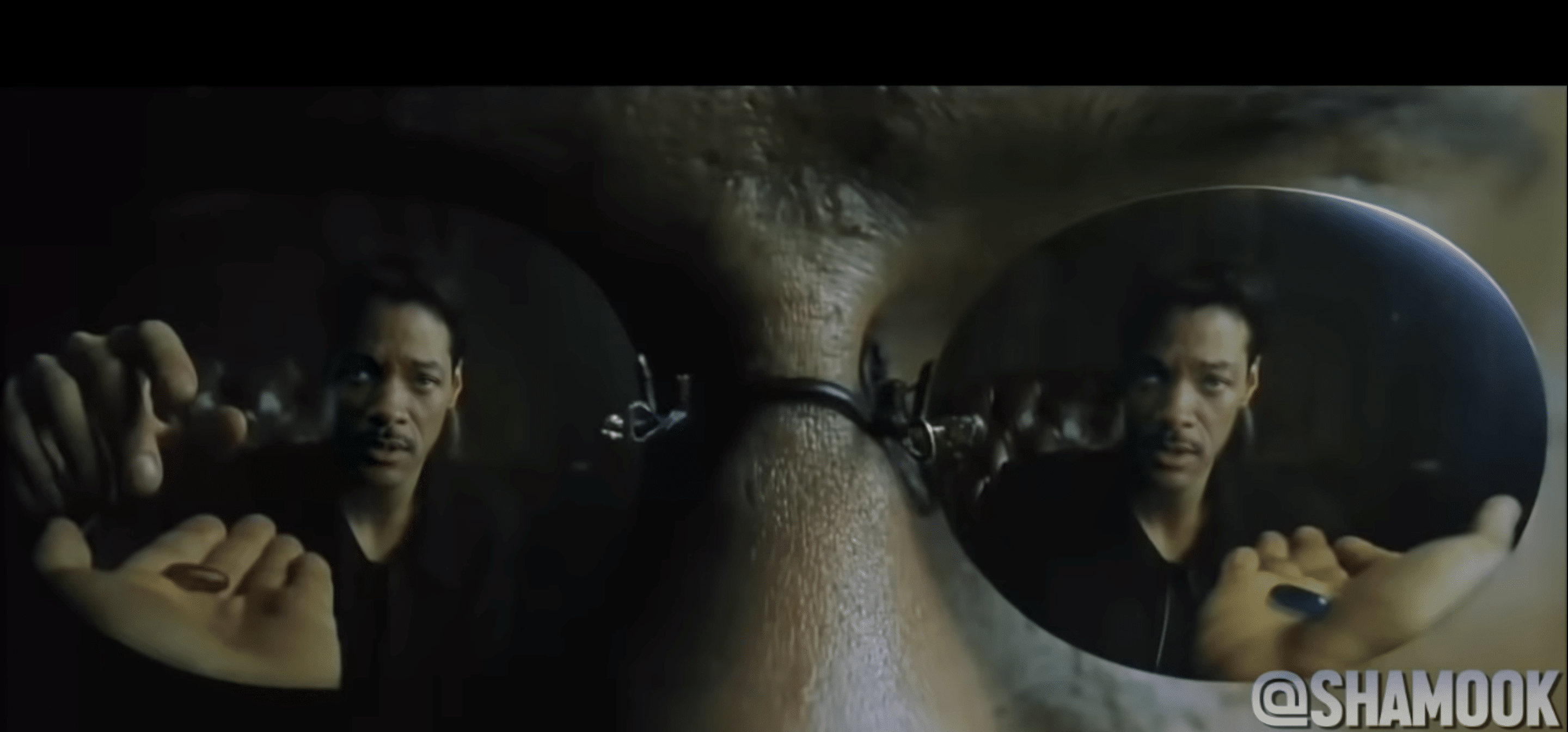
Today’s technology allows us to simulate what the famous Matrix scene with Will Smith would look like as Neo. Source: Shamook YouTube chanel
It’s interesting to think about what The Matrix would have looked like with Will Smith as Neo… but it’s probably hard to imagine anyone other than Keanu in that role today.
Reason #1: The curse of knowledge prevents the client from understanding you
What does “curse of knowledge” mean?
The psychological phenomenon known as the “curse of knowledge” represents one of the most significant yet overlooked barriers to successful B2B communication. Originally studied by psychologists in the 1990s, this cognitive bias occurs when experts become so familiar with their subject matter that they lose the ability to imagine what it’s like not to know that information.
In B2B, we often need to provide the customer with a lot of information to complete the sale successfully:
- What is the business value of our offer,
- What exactly are we going to deliver,
- At what time,
- How,
- Under what conditions
- For how much, etc.
And here is where the curse of knowledge stands in our way.
The curse of knowledge is a psychological effect, which means that if we know something, we get the impression that others do too. [More about the curse of knowledge is written here]. This crucial development in understanding buyer psychology helps explain why so many promising negotiations fail.

This bias is particularly dangerous in technical industries where solution architects, engineers, and product specialists create marketing materials. They unconsciously assume that terms like “API integration”, “scalability” or “ROI optimization” carry the same weight and understanding for prospects as they do internally.
The result?
Communications that sound impressive to experts but leave decision-makers confused and disengaged.
It usually takes harmless forms. When we watch the program “Who Wants to Be a Millionaire?” and we know the answer to the question, we are surprised that the player is even thinking about it. It’s so obvious, right?
For a football fan, it will be “obvious” which football club Robert Lewandowski plays for, for a fan of the Lord Of The Rings, it’s obvious who Faramir was, for an amateur traveler, what the capital of Madagascar is…
As Polish host of “Who Want to Be a Millionaire” Hubert Urbański says:: “That’s the joke of it, that you can find questions that are easy for us and difficult for someone else.” [3]
However, the knowledge curse is very dangerous in the case of marketers and sellers. It can destroy the potential of even the best product.
Consider this:
Stanford research demonstrates that when people know the answer to something, they consistently overestimate others’ ability to guess correctly. In their famous “tapper and listener” experiment, people tapping out songs believed listeners would identify them 50% of the time, when in reality, success rates were only… 2.5% 🙈. [4]
This same dynamic plays out in countless sales presentations where experts tap out complex solutions while prospects struggle to hear the melody.
Why?
Marketing and sales materials are usually created by experts. People who know the product through and through. People who may, therefore, get the wrong impression that certain things are “obvious” and there is no need to talk about them.
The result is that they release sales material that omits a lot of important information.
Modern buyers expect clarity and transparency more than ever. The business buyers expect companies to proactively understand and cater to their needs. When materials assume too much knowledge, they create friction rather than building confidence in the solution.
Just like the interactive whiteboard presentation I took part in. The salesman talked for 1.5 hours (!) about how many plugs the product has, how much power it uses, and how to connect it to the phone, but he did not explain how it could help me run my business and why I should buy it – at all.
Classic mistake. The salesperson was like that friend who explains how a car engine works when all you wanted to know was “Will it get me to work reliably?” or in other words:
“So what’s in it for me?”
Sure, he was smart, probably knew more about that whiteboard than anyone in the room. But he forgot that buyers don’t care about your product’s bells and whistles. They care about their problems. This happens a lot when technical people try to sell. They get excited about how cool the technology is and forget to explain why anyone should care.
The Wachowski brothers fell into this trap. The plot of “Matrix” was evident to them, so they focused on discussing the technical details of the film – special effects and individual scenes.
Will Smith, not understanding what the “Matrix” was all about, rejected the offer to play a role in it. In the same way, the client often rejects an offer without understanding the “big picture”, which is seeing what such cooperation can bring him.
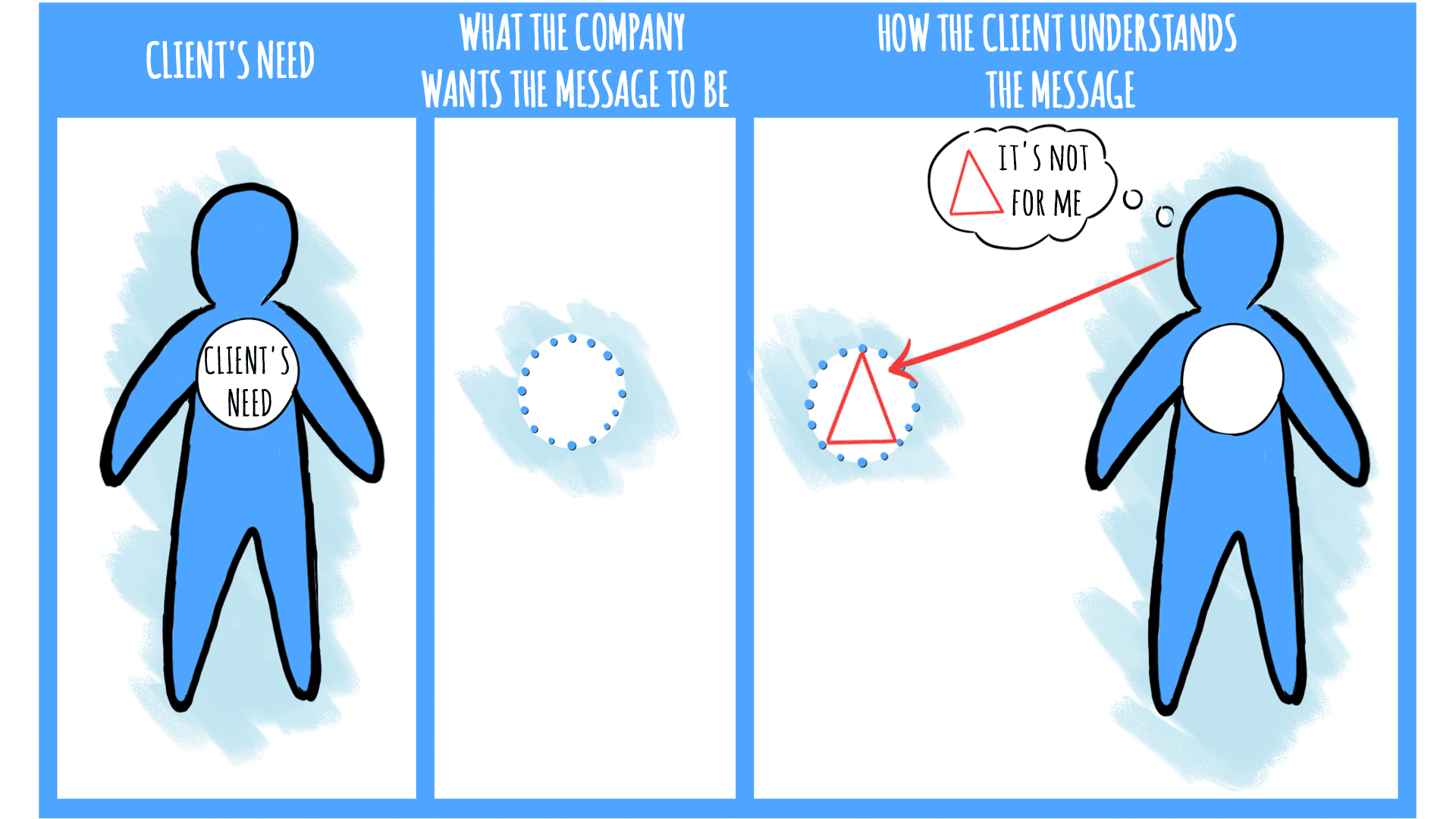
Often the customer has difficulty in understanding marketing and sales materials. If he wrongly connects the dots we draw for him, he may reject our offer. Even if our product could help his company.
Can you break free from this damned curse?
I’ve seen companies crack this, but it’s not pretty at first. What they do is simple but painful. They make their product experts sit down with people who know nothing about what they’re selling. Could be the receptionist, could be someone from legal. They do it to learn fast how to make an offer land in the basket. The rule is:
explain it so they actually understand what you’re talking about.
Watching a brilliant engineer try to describe cloud computing to the office manager? Priceless. And educational. Suddenly all those assumptions about what is obvious go right out the window. Moments like this show how to make an offer land in the basket.
Want to save your people some stress?
There’s actually a smarter way to do this. Instead of putting your engineers through the torture of explaining complex concepts on the spot, create explainer videos that do the heavy lifting for you. You can craft the perfect explanation once, test it with real people, refine it until it clicks, and then use it everywhere.
Your sales team gets consistent messaging.
Your prospects get clarity.
Your technical experts can focus on what they do best.
Example explainer video: Key OSS and BSS categories. Animation series created for Suntech. Due to the technical complexity of the subject matter, the company chose animated storytelling to break down difficult concepts and keep their audience engaged throughout the learning process.
Reason #2: You don’t get to the right people on the purchasing committee
Today, B2B buying isn’t a one-to-one chat anymore. Instead, your pitch lands in front of a diverse group. Procurement, IT, finance, even legal – each with their own agenda. If you don’t address the concerns of the real decision-makers, your offer never gets the green light. The situation becomes even more difficult with the fact that, in B2B, there are usually several recipients of our materials.
According to Gartner’s research, on average, 7 people are involved in B2B purchases. [5]. However, recent studies note that the modern buying committee typically includes 11 people in today’s complex purchasing environment. These are often people in different positions.
Let us take the CRM system as an example. Apart from people from sales and marketing, the president, purchasing, IT, legal or the finance department may be involved in the process of its purchase.
- 7 different people.
- 7 different goals.
- 7 different levels of CRM knowledge.
Each stakeholder evaluates the proposed solution through their unique lens of concerns and success criteria.
- The IT director focuses on integration complexity and security implications.
- The CFO examines the total cost of ownership and financial ROI.
- End users worry about learning curves and daily usability.
- Legal teams scrutinize compliance and contractual terms.
This diversity of perspectives creates both opportunity and challenge for sellers.
Although there is usually one decision-maker, every person involved in the process has more or less of an influence on it. It is, therefore, worthwhile for marketing and sales materials to meet the needs of at least some of them.
Especially since products must meet many criteria – RODO compatibility, functionality, ease of integration, the convenience of use, etc. Different stakeholders digest information in their own ways. Tech leads dive into specs and system diagrams. Finance teams look for clear ROI and cost breakdowns. Executives want the big-picture fit with their strategic goals.
A one-size-fits-all slide deck simply won’t cut it for such a varied audience.
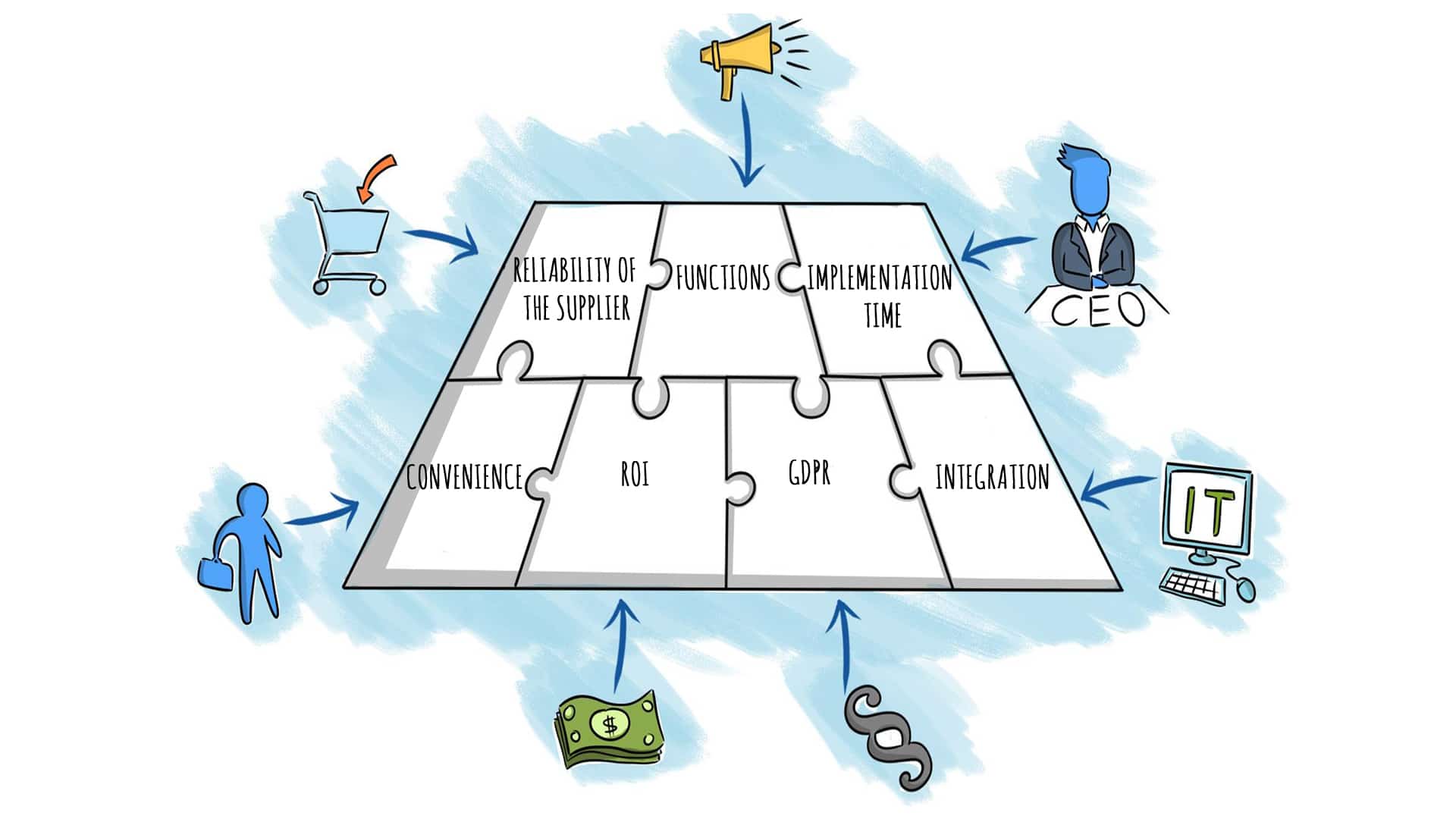
Example criteria for decision makers when purchasing a CRM.
What happens if you skip data integration or GDPR details? Those in charge of these topics might slow down decisions… or even derail them.
And this isn’t about playing dirty. Stakeholders who feel ignored will voice objections or demand extra reviews, putting the brakes on the whole deal. Remember, in committee settings one doubtful voice can override everyone else, especially since these meetings happen behind closed doors.
To navigate this, top sales teams map out the decision-makers in advance, understand who holds the power, and craft specific messaging for each role. It’s more than winning over a champion. It’s about aligning a whole committee around your proposal using account-based marketing tactics.
Reason #3: Most sales take place when you are not there.
This is best illustrated by an experienced industrial sales manager, Neil Rackham, who wrote “SPIN sales”:
“I’m convinced that the reason I managed to sell the system for many millions of dollars was that I spent a lot of time making sure that people I talked to knew how to sell for me. I was like a theater director. I worked during rehearsals – I wasn’t on stage when it was time for the show.” [4]
Interestingly, this is a statement from over 30 years ago. Rackham’s insight is even truer today. Buyers now do most of their homework on their own. Researching online, comparing alternatives, and debating options internally. Long before they ever speak to a vendor. Those face-to-face meetings are becoming the exception rather than the rule.
Today, customers are even less willing to involve the salesman in making decisions. On average, purchasing committees spend only 17% of their time on meetings with suppliers. [7] And 60% prefer not to treat a salesperson as their main source of information. [8]
Buyers today simply don’t need to meet vendors to do their homework. Everything they want: reviews, portfolio, case studies, competitor comparisons, recs from peers, is just a click away. And you know what? They love it! They can research at their own speed, on their own terms, without anyone breathing down their neck.
Therefore, it is our customer contact person who will convince others to choose us, which means that he or she will de facto be selling. As if he or she were our distributor.
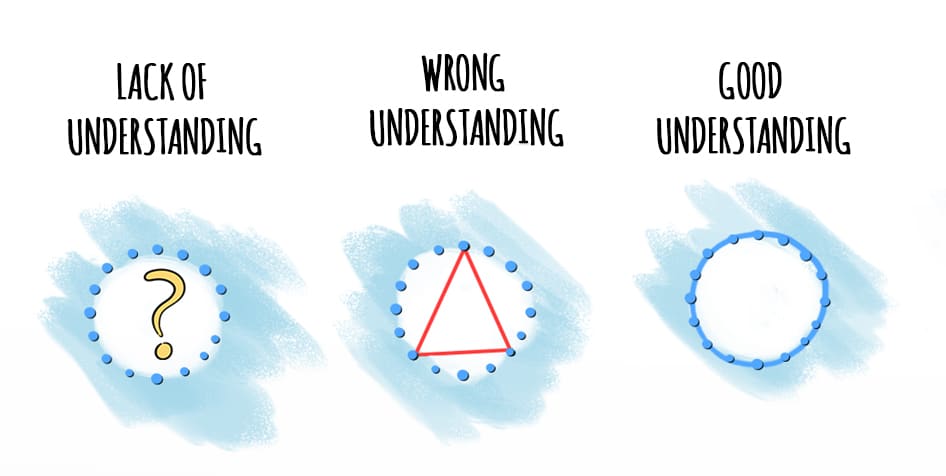
Our contact person’s role is to make the whole Purchasing Committee connect the dots precisely the way we want them. When teams must negotiate the total amount of investment with multiple stakeholders, misunderstanding our offer can sometimes be worse than not understanding.
It is our contact person who will be under fire from questions about ROI, integration with other systems, FAMILY, etc. If we don’t prepare him or her for this and provide the right marketing materials, he or she will fail.
And we will hear “thank you for the offer, we decided to cooperate with another supplier” or “for this moment, we have suspended the project, we will contact you when we return to the topic”.
That is why it is so important that our contact person on the client-facing side understands our offer well. And he or she can explain it neatly and convincingly.
It’s up to us to make sure he or she gets it right. This is how to make an offer land in the basket.
Reason #4: Your offer does not stand out from the (numerous) competitors
Let’s go back to Will Smith.
He has many offers to choose from, and he has to know exactly how the product will help him just as Will Smith can afford to reject an offer whose benefits are not entirely clear to him.
And this is the fourth reason why our offer can land in the basket. Multiple suppliers’ offers and minimzation risk.
When he talked to the Wachowski family, he was already a star. But the Hollywood world is merciless. One, two bad decisions, and you fall off the pedestal. In such a situation, playing in a film by unknown directors, which you are not convinced of, sounds very risky. It makes more sense to wait for something that will be an obvious hit.*
*Fifty thousand scripts are made in the US every year. Only 150 of them are produced in Hollywood. That’s less than 0.3%. [9]
How market value determines the total amount of investment?
When buyers assess any proposal, they must first determine its market value before committing to the total amount of any significant investment. This evaluation process typically involves multiple stakeholders who each bring their own perspective to the table.
In the B2B buying world, every decision carries personal weight. A wrong choice can leave a mark on someone’s career. That’s why many prefer to stick with established brands rather than take a chance on a newcomer. As the saying goes, “nobody ever got fired for buying from the big guys.”
In hyper-competitive environment, the buyer feels the same way.
They’re buried under endless offers. Every company claims to have the perfect solution and a track record of happy clients. Faced with such overload, the safest move is often to go with a name they already trust. The antidote is showing fast how to make an offer land in the basket, removing doubt and making your choice feel like the safest one.
As they say, no one was fired for buying IBM products. So, if we don’t have a position like IBM or Microsoft, we have to make up for it with clarity and consistency of message. Especially today, when no one has time to analyze 50-page offers. And according to Gartner, customers who found the vendor’s sales materials consistent, bought from them 4.5 times more often on average! [10]
To stand out, you need more than another list of specs. The winners in B2B know exactly what makes them different – niche skill, a fresh delivery model, or a customer service promise no one else can match. And they don’t hide it. From the first email to the final contract, that unique angle shines through, reminding buyers why this solution isn’t just another line on their spreadsheet.
Your edge needs to pop out at first glance and speak directly to what keeps your buyer up at night. Forget vague buzzwords like “innovative” or “customer-centered” (everyone uses them🙈). Instead, share real examples:
– This company cut costs by 30%.
– That team shaved weeks off their rollout.
Show the numbers, the before-and-after stories. Let prospects see themselves in your success stories.
If the Wachowski brothers had been able to talk about the plot of the Matrix, Will Smith would probably have accepted the role. However, they presented it in such a way that their film seemed to be just “another action film.”
In business, the lesson is the same: if your pitch blends in with the rest, buyers will stick with the familiar name rather than gamble on “just another” supplier.
To truly set yourself apart, you have to marry what you do best with what your prospect needs most
That means hunting down where others fall short (maybe they overpromise on integration or leave security gaps) and showing exactly how you fill those holes. When your solution addresses a pain point no one else even sees, differentiation happens naturally.
So the situation is more or less like this:
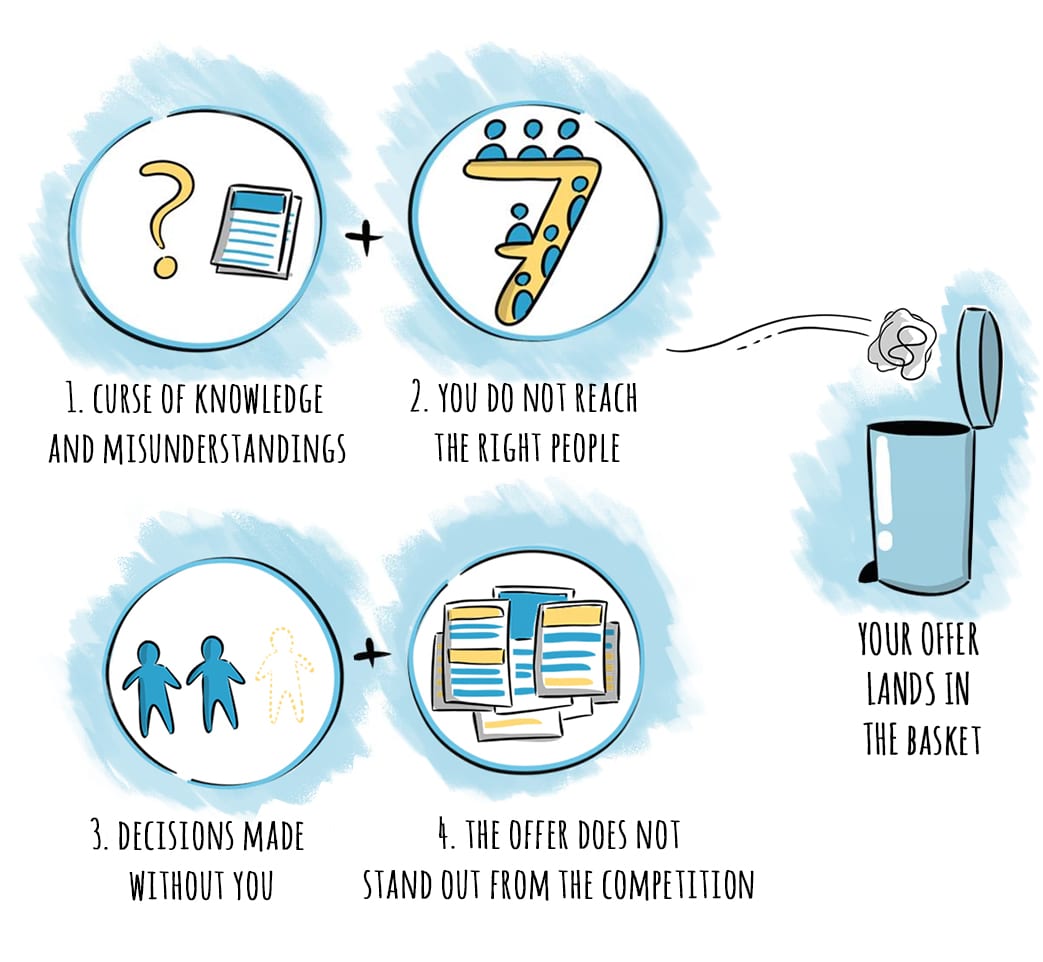
Knowing these four pitfalls is just step one. The hard part? Actually fixing them in your own sales game. Companies that keep winning deals don’t just hope for the best. They build their approach around how people really think, how committees really work, and how to actually stand out from the crowd. In practice, that means operationalizing “how to make an offer land in the basket” — turning it into repeatable steps your whole team can execute.
If your offer is rejected the next time, think about whether you have taken care of these 4 elements.
This is not an easy task. But the trend is clear and difficult to fight. That’s why we can only adapt to it.
Here’s the brutal truth about B2B selling now: your product demo isn’t enough anymore.
Selling B2B today means you can’t just show up with a PowerPoint and hope for the best. You need to understand how people really make decisions, how their organizations actually work, and what makes committees say yes or no. In this house of complex stakeholder dynamics, successful companies that figure this out will crush those still doing business like it’s 2005.
That’s also why we’ve built a list of questions that will help you prepare an offer that fits these realities.
This comprehensive agreement between sales methodology and buyer psychology creates the foundation for sustainable success. Among the questions, you will also find good examples of offers from companies such as Wells Fargo, CallPage, IBM, Microsoft or Brand24, which will help you get inspired.
SOURCE:
[1] ClientPoint: The Top 20 Reasons Why B2B Companies Will Reject Your Business Proposal [link: The Top 20 Reasons Why B2B Companies Will Reject Your Business Proposal]
[2] Will Smith interview: https://www.youtube.com/watch?v=hm2szuXKgL8
[3] Hubert Urbański himself mentions this effect (without calling it that) when they ask him about the most difficult question in Millionaires [link: https://www.youtube.com/watch?v=BhMD6I4O5jc].
[4] University of Arizona The Curse of Knowledge [link: The Curse of Knowledge | UCATT]
[5] Garner’s reasearch about decision making in B2B: https://blogs.gartner.com/hank-barnes/2016/09/27/in-enteprise-tech-sell-broadly-is-the-only-answer/
[6] Rackham, Neil. SPIN Selling: Situation Problem Implication Need-Payoff (p. 85).
[7] Garner’s research about shopping time spent on meetings with the seller:
https://www.gartner.com/en/sales-service/insights/b2b-buying-journey
[8] Forrester’s article about the client-seller relations https://go.forrester.com/blogs/the-ways-and-means-of-b2b-buyer-journey-maps-were-going-deep-at-forresters-b2b-forum/
[9] Number of scripts produced in Hollywood: https://www.theatlantic.com/entertainment/archive/2011/09/how-hollywood-chooses-scripts-the-insider-list-that-led-to-abduction/245541/
[10] Gartner’s research about buyer’s behavior: https://www.gartner.com/smarterwithgartner/what-sales-should-know-about-b2b-buyers-in-2019/


